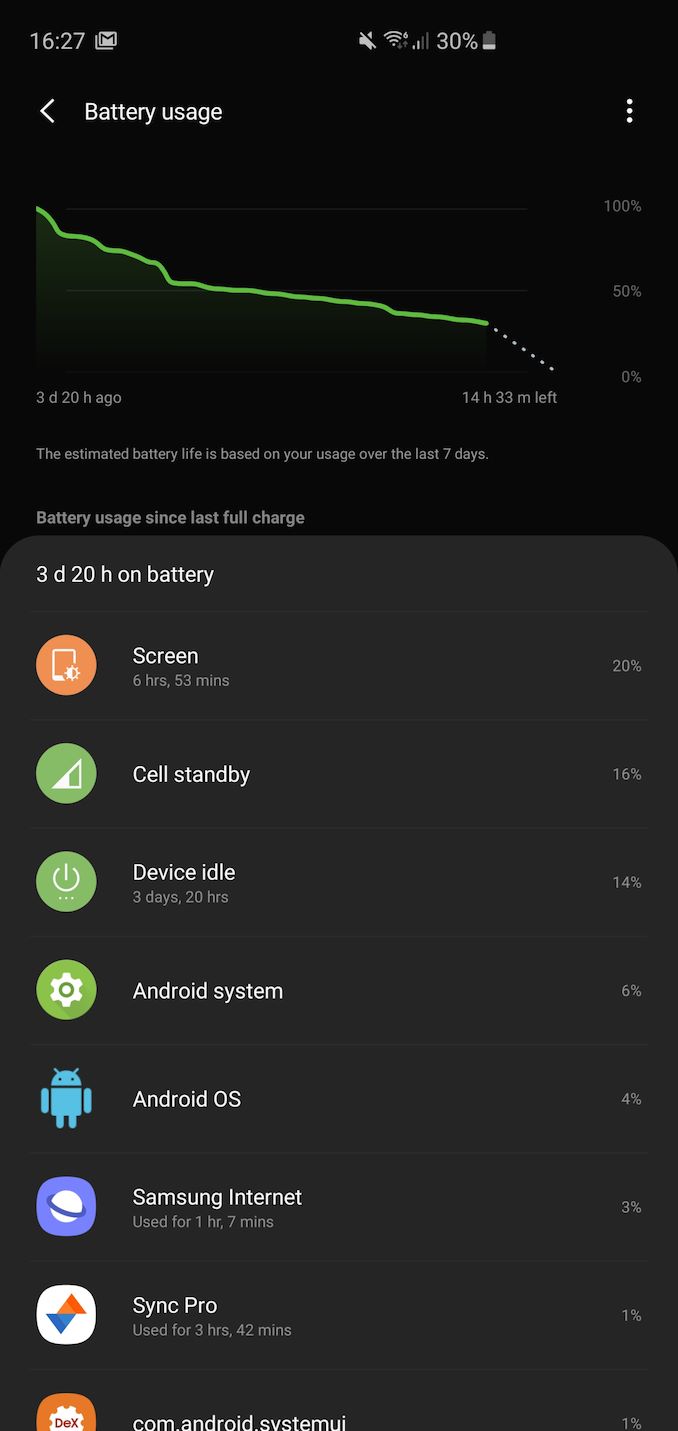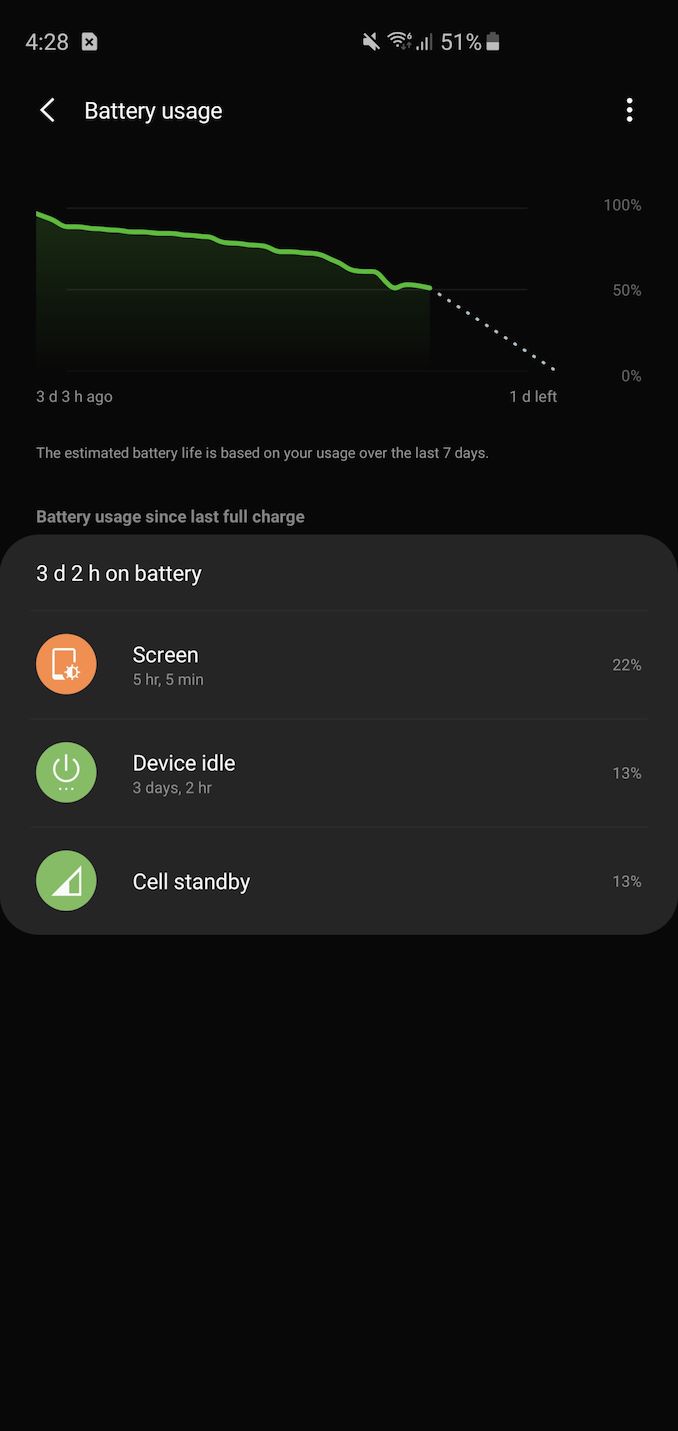The Samsung Galaxy S10+ Snapdragon & Exynos Review: Almost Perfect, Yet So Flawed
by Andrei Frumusanu on March 29, 2019 9:00 AM ESTBattery Life: Impressive
Battery performance of the Galaxy S10+ has been touted to be as class-leading. The introduction of a larger battery, more efficient screen as well as a new generation of SoCs are sure to bring improvements over last year’s Galaxy S9. One aspect that readers will have waited for impatiently is our testing of the new Exynos 9820 variant against the Snapdragon 855, which has also been one topic I’ve been extremely interested to see.
We run Samsung's Galaxy devices at the full potential they can deliver, something we've done for several generations now. This means that the screen resolution is set to the native 1440p of the display panels, and the new battery settings on the S10 were also set to "Performance" mode.
Without further ado, let’s get do the results:

In our web browsing test, both Galaxy S10+s are showcasing outstanding longevity at 13.08h for the Exynos and 12.75h for the Snapdragon variant. Least to say, I was extremely surprised to see this result even though we measured the Exynos 9820 CPU to be quite less efficient than the Snapdragon 855 in peak performance efficiency. I would have not expected the Exynos to match the Snapdragon, much less slightly beat it.
Before going into more details, let’s see the PCMark battery test results:

Here, in absolute terms, the Galaxy S10+ aren’t quite as impressive as on the web test and further lag behind the excellent results of the Kirin 980 devices. Nevertheless, these are some impressive figures and again it’s very good to see that both units are almost evenly matched, this time the Snapdragon unit lasting slightly longer than the Exynos.
To explain these results, we have to keep one thing in mind: the Exynos unit will have posted worse performance than the Snapdragon, so it will have spent more time at the lower more efficient frequency states.
One thing that I also noticed, is that in very low idle loads where there’s just some light activity on the A55 cores, the Exynos 9820 variant actually uses less power than the Snapdragon unit. The figures we’re talking about here are 20-30mW, but could possibly grow to bigger values at slightly more moderate loads. It’s possible that Qualcomm has more static leakage to deal with on the 7nm process than Samsung on 8nm, one thing that I’ve come to hear about the TSMC 7nm node.
Furthermore, one of the biggest improvements for the Galaxy S10 over past devices isn’t actually the SoC nor the actual bigger battery. It’s actually the display as well as the base power consumption of the phone. In Airplane mode, the base power has gone down by almost 100mW compared to the Galaxy S9+ which is a fantastic development and is especially something that will result in higher low-brightness battery life.
Currently in my time with both S10+ units, I can say they’ve been among the longest lasting Android devices I’ve tested.


Exynos vs Snapdragon in identical usage patterns & Prolonged idle periods
One issue I can confirm with the Exynos unit is that after a voice call in any app, the phone isn’t correctly entering its lower power state, and will suffer from increased idle battery drain until a reboot. This is something that hopefully Samsung addresses in a firmware update as it doesn’t look to be a hardware related issue. When not affected by this bug, both phones idle very similar to each other and slightly better than the S9+ I use as my daily device.










229 Comments
View All Comments
GekkePrutser - Saturday, March 30, 2019 - link
The orientation of the selfie camera in this case significantly reduces the experience and overall screen space from what would be possible. And smartphones are all about the screen. Making a big hole in it is really annoying.I'd personally find it a lot less flawed if it just left the selfie camera out altogether as I'd gladly do without it, or just kept the bezels.
Tropicocity - Sunday, March 31, 2019 - link
So your solution to what is actually the smallest and least-intrusive version of a 'total full screen display' (screen to body ratio is the highest ever pretty much, save for a few gimmicky ideas) is to remove it entirely?Linus seems to be in love with the front-and-back display idea, where there's a whole extra screen on the rear so you turn the phone around completely to take a selfie. Personally, I think the cutout is way better compared with the 'notch' on other phones. Sure, the s10+ having a double one isn't as nice as the singular one on the regular S10, but you get better depth-sensing and better selfies out of it.
Zoolook - Saturday, March 30, 2019 - link
Isn't that a bit like tying one arm to your back for a while because it's so good when you release it?drajitshnew - Friday, March 29, 2019 - link
Thank you ANDREI. This is really nice, comprehensive, review with very useful conclusions. I really liked it.apexjr - Friday, March 29, 2019 - link
Andrei Frumusanu,You nailed this display part! I actually returned my first S10 yesterday because the calibration wasn't great. I saw way too much greens while looking at a grey display. Nothing I could do fixed it.
On my next S10 the calibration was better. I selected Vivid, max'd out Cool, reduced green by 2 notches. That seemed to get the white closer to white, even though there is still a bit too much red/yellow mixed in. It is acceptable now though.
Would you possibly try adjusting it within the vivid sections to maybe get a better color accuracy?
I don't know what is going on with this display. I bought a S9 for my daughter at the same time and the colors are much better/accurate. The contrast is a bit too punchy though, as dark scenes are rendered too dark. This is what you are talking about and continues to be in the S10 (but to a lesser degree in my two phones).
Thanks!
nicolaim - Friday, March 29, 2019 - link
Typo on the last page: "the SoC represents be"nicolaim - Friday, March 29, 2019 - link
And another: "comfing"Andrei Frumusanu - Friday, March 29, 2019 - link
Thank you.SwordOS - Friday, March 29, 2019 - link
also s10s don't have iris scanner..danwells - Friday, March 29, 2019 - link
There's only one problem with any ultra-high-end Android phone... Apple!If you're going to pay for a phone that's in the Apple price range, the average person would be MUCH better off with an iPhone - you can avoid Android's security problems, ads and tracking entirely. Every performance test posted that included modern iPhones also showed the iPhones are faster and more power efficient.
Yes, there's a small fraction of the market (and a larger fraction of AnandTech's readership) that prefers the greater customizability of Android, and that's fine as long as they're aware of the security risks and don't mind the ads and tracking. 9 out of 10 people who are in the segment of the market that contains the modern iPhone ($750+) are better off with an iPhone, and the other 1/10 know why they don't want one.